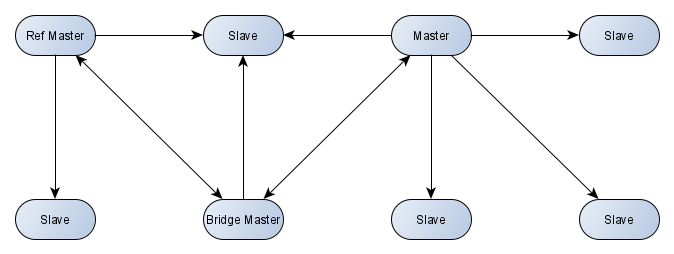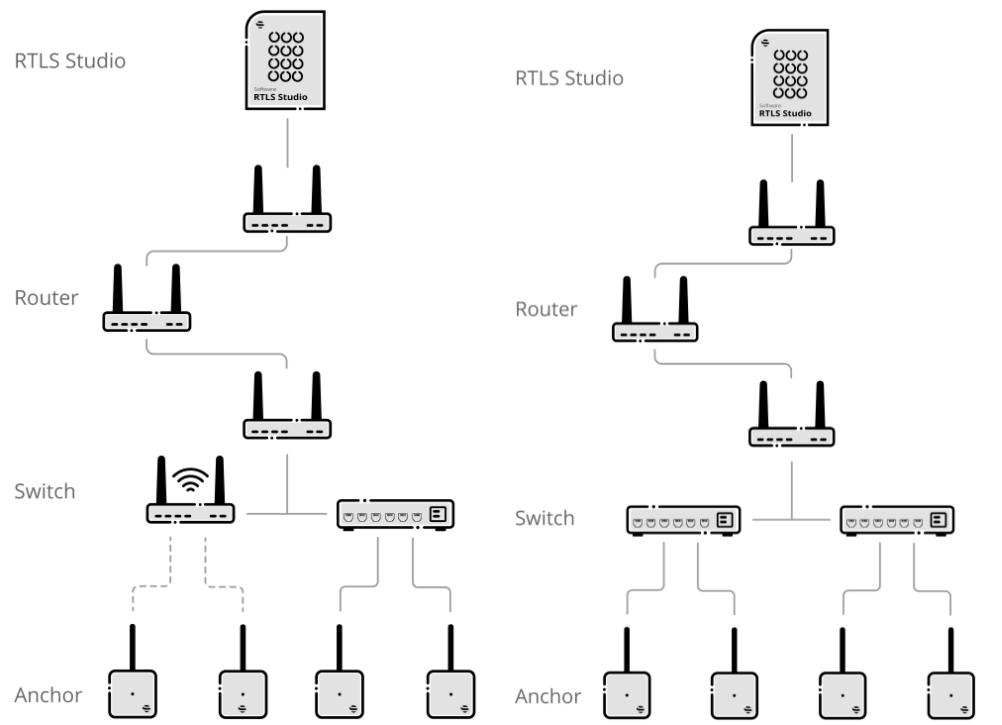TCP Synchronization
Overview
Synchronization of anchors is an essential part of TDoA location powered RTLS to ensure reliable and sub-meter position accuracy. RTLS Studio now supports not only UDP Sync but also the TCP Sync gen2 scheme to empower greater flexibility of network deployments as the synchronization can now pass through multiple routers.
On this page you can find theory about TCP Synchronization to understand how it works. If you would like to see how to change configuration for TCP synchronization, you can find it in section Using TCP Synchronization.
Benefits
- RTLS Studio can be deployed on a different network than the anchors. TCP synchronization passes through the routers
- Auto anchor alignment in TDMA is driven from RTLS Studio entirely independently of the network infrastructure with microsecond precision. No additional precise synchronization hardware, such as IEEE 1588, is needed
- SYNC timeslot per master anchor is reduced by half, which allows you to use more master anchors
- Self-healing and automatic joining of multiple time domains
Anchor Assignment in TDMA Explained
Let’s explain assigning anchors into time slots, known as Time Division Multiple Access (TDMA), in more detail using the RTLS layer model.
TCP SYNC lies within the second layer – see the picture of Synchronization Layer Model above. To provide positioning coverage among all the anchors, selected anchors (master anchor) must synchronize with the rest via UWB transmission (layer 3). The anchor contains a single UWB radio, so it can either transmit the synchronization or receive blinks from tags at that time. If there are multiple master anchors within the same radio range, they should not transfer at the same time. Otherwise, a radio collision would occur. On the other hand, if they are not at the same range, their transmission could overlap, thereby utilizing over-the-airtime optimally. TCP Sync implements aligning anchors within the TDMA, which is done via a persistent unicast TCP connection with each anchor. Since optimal alignment can become a very complex optimization problem, especially as the number of anchors grows, we have employed an advanced machine-learning-based genetic algorithm to calculate the optimum solution in almost real-time.
From RTLS Studio 2.3 TCP Synchronization has got a new UX interface in RTLS Manager.
Terminology
Consider the following example:
This graphic illustrates the Anchor TCP Sync Roles that will be used through this documentation to elucidate how TCP Sync works. From this diagram we can define the following Anchor TCP Roles:
- Reference Master - the central point of time for TDMA synchronization for Anchors, Masters, and Slaves. RTLS system can have more Anchors in the role of Reference Masters. Each Reference Master means a separate time domain of TDMA synchronization. For UWB synchronization Reference Master acts as a regular Master.
- Time Domain - group of anchors sharing same time clock synchronization of Reference Master.
- Bridge Master - the special role of anchor. The role of the bridge master is to merge time domains. For UWB synchronization acts as a Slave, but for TDMA synchronization acts as a Master. Bridge Master can be synchronized by the Master or Ref Master. Bridge Master can not be synchronized by different Bridge Master and vice versa.
- Master - anchor which is sending and receiving UWB sync. For TDMA sync the Master is spreading clock synchronization of his time domain. Master can be synchronized by Master, Ref Master, or Bridge Master.
- Slave - anchor in this role is just receiving synchronization of TDMA and UWB. A slave anchor can be synchronized by Master, Ref Master, or Bridge Master.
The summary which role act as a master for TDMA sync and UWB sync is presented in the table below:
| TCP Sync role | TDMA Sync role | UWB Sync role |
|---|---|---|
| Ref Master | Master | Master |
| Bridge Master | Master | Master |
| Master | Master | Slave |
| Slave | Slave | Slave |
TCP Sync Network Topology Example

